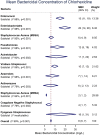Bacterial sensitivity to chlorhexidine and povidone-iodine antiseptics over time: a systematic review and meta-analysis of human-derived data
- PMID: 36611032
- PMCID: PMC9825506
- DOI: 10.1038/s41598-022-26658-1
Bacterial sensitivity to chlorhexidine and povidone-iodine antiseptics over time: a systematic review and meta-analysis of human-derived data
Abstract
Surgical site infection (SSI) is the most common complication of surgery, increasing healthcare costs and hospital stay. Chlorhexidine (CHX) and povidone-iodine (PVI) are used for skin antisepsis, minimising SSIs. There is concern that resistance to topical biocides may be emergeing, although the potential clinical implications remain unclear. The objective of this systematic review was to determine whether the minimum bactericidal concentration (MBC) of topical preparations of CHX or PVI have changed over time, in microbes relevant to SSI. We included studies reporting the MBC of laboratory and clinical isolates of common microbes to CHX and PVI. We excluded studies using non-human samples and antimicrobial solvents or mixtures with other active substances. MBC was pooled in random effects meta-analyses and the change in MBC over time was explored using meta-regression. Seventy-nine studies were included, analysing 6218 microbes over 45 years. Most studies investigated CHX (93%), with insufficient data for meta-analysis of PVI. There was no change in the MBC of CHX to Staphylococci or Streptococci over time. Overall, we find no evidence of reduced susceptibility of common SSI-causing microbes to CHX over time. This provides reassurance and confidence in the worldwide guidance that CHX should remain the first-choice agent for surgical skin antisepsis.
© 2023. The Author(s).
Conflict of interest statement
The authors declare no competing interests.
Figures




References
-
- Zimlichman E, et al. Health care-associated infections. JAMA Intern. Med. 2013;173:2039. - PubMed
-
- Garner BH, Anderson DJ. Surgical site infections. Infect. Dis. Clin. N. Am. 2016;30:909–929. - PubMed
-
- Badia JM, et al. Impact of surgical site infection on healthcare costs and patient outcomes: A systematic review in six European countries. J. Hosp. Infect. 2017;96:1–15. - PubMed
Publication types
MeSH terms
Substances
LinkOut - more resources
Full Text Sources

